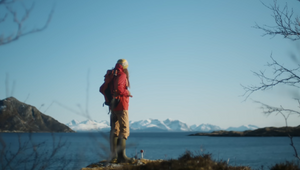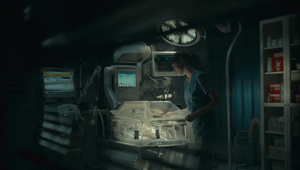
Making the Grade: Being Harmonic, Not Heavy-Handed with Siggy Ferstl

Siggy Ferstl has brought his keen eye and extensive technical expertise to an impressive group of major feature films, episodic TV shows, and commercials. His extensive list of credits includes the highly anticipated Netflix series "Avatar: The Last Air Bender" as well as that streamer’s beloved series “Wednesday,” their wildly popular “The Night Agent,” the well-received big-budget sci-fi series “Lost in Space” and international sensations “Narcos” and follow-up “Narcos: Mexico.” He has also coloured a high-profile, unique-looking Prime Video science fiction series, “The Boys,” and its spinoff, “Gen V.”
As a technical innovator, Siggy is constantly developing new approaches to colour grading as his ever-evolving toolset expands. In the case of Disney’s innovative feature “Togo,” Siggy utilised then-brand-new tools within colour corrector DaVinci Resolve to collaborate with director/cinematographer Ericson Core on a complex and unique look to shape the film’s 1920s period look and frozen tundra feel — look development which would previously have required a significant amount of VFX work to realise. Siggy has also coloured literally hundreds of spots for major international companies, including Nike, Mercedes Benz, and Cadillac, to name a few.
Siggy joined Company 3 Los Angeles in 2008 after having established himself as a go-to colourist, first in his native Australia and subsequently throughout southeast Asia and London. His experience living and working in these three key regions, each with its own cultural approach to colour, has given Siggy a unique perspective on the wide variety of attitudes about art, the collaborative process, and colouring styles in these varied markets. Siggy's talents have been recognised by organisations including the AICE (Association of Independent Creative Editors); the Lumiere Awards, where he took the award for Best Use of HDR in a Series for his work on “Lost in Space”; and the HPA (Hollywood Professional Alliance), which has given him multiple colour grading awards and even more nominations.
LBB> What was your first experience with the world of colour grading – and when did you decide that being a colourist was a role that you wanted to pursue?
Siggy> My first experience with colour grading was as a 16-year-old during work experience through my school over the summer. I fell in love with it instantly and I was incredibly lucky at the end of it to be offered a job as a junior telecine assistant.
LBB> What was the project that you felt really changed your career?
Siggy> I don't think there was an individual project that changed my career, but I do remember the very first commercial I did, which was a candy commercial. I also graded the very first feature DI in Australia and pioneered a lot of aspects of that workflow. I started working in the US 20 years ago, and looking back there have been so many projects along the way that I'm proud of that it would be hard to select just a few.
LBB> How/where did you hone your craft, and did you have any particular mentors?
Siggy> I started my career in Melbourne, Australia, and was lucky enough to work with some of the best telecine colourist at the time. I really learned about film and some of the more technical aspects of getting the best out of every image.
LBB> Tell us more about your creative process.
Siggy> When I see the images for a commercial, my first impressions are usually about how it was shot. I try to put myself in the cinematographer’s headspace before having a conversation with the creatives to see what their ideas and expectations are for the spot. I usually weigh up all those factors, and I like it when I can have the time to get a feel of the images, and then develop a look once I have all that information
LBB> From experience, we’ve found that colourists often love art and photography - when you’re out of the studio, what inspires you?
Siggy> Yes, I love photography and have from an early age. I love being out walking or hiking with my dog, and during the summer I love to stand-up paddle board, surf or just swim.
LBB> Colour grading is largely a digital affair, but there’s also been a resurgence of film over the past few years in commercials and music videos. What are your thoughts about working on film versus digital formats like 4K? And what are your favourite techniques for capturing a vintage or tactile feel?
Siggy> I love film. It definitely has a look and feel to it that is very different to digital formats. I often blend certain film characteristics when working with digital formats. Building new lookup tables or LUTs for different looks can be quite rewarding. I believe as a colourist, choosing the right lookup table for the job can be the equivalent of a cinematographer choosing the style of lens. Both can really change the feel and look of images.
LBB> When working in commercials, what role can colour and a grade play in enhancing a brand’s assets and what sort of conversations do you have with creatives and clients about that
Siggy> Colour correction can be as simple as enhancing the brand colour or product and making it stand out. But it can also be used as a feeling -- a look and a style -- that can be difficult to describe. I often get reference images that aren't necessarily a literal translation of what the creators are looking for, but references can provide more of a feeling. This really sets the mood which I love. It allows you to discover.
LBB> How do you ensure that each colourist-director partnership is a success?
Siggy> You're not going to have successful relationship with every director you work with. There are so many levels where you need to be on the same page with them. You need to have an understanding of each other and a trust. And those things are often built up over a number of jobs together.
LBB> What advice would you give to budding colourist?
Siggy> The best advice is to colour as much material and as many varying types of material as possible. Get as much time under your belt as you can.
LBB> In your opinion, what’s difference between a good grade and a great grade?
Siggy> That's always a very difficult question to answer. You never know what the underlying images were like. You could have some beautifully photographed images where you as a colourist have done very little and the end product is exceptional, or you could be working with images that are inconsistent and have little latitude that requires you to really pull out the best you can.
Being too heavy-handed is often a trap. Forcing the colour in a different direction to the photography is not great either. Ultimately, you don't want the grade to be getting in the way of the look and feel of the actual images. They need to be in harmony with each other.
LBB> How is the craft and trade of colour grading changing?
Siggy> Technology is developing at an incredible speed. Not only are the colour tools constantly being updated, but also the increase in latitude and resolution of cameras, improved capture formats and all the various display platforms, including HDR, all require an artist to be aware of so much more than we had to be 10 or 20 years ago.















